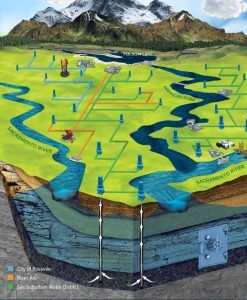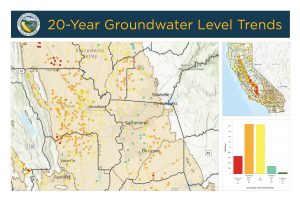By Jim Peifer
California recently marked a landmark moment with the passage of SB 659, known as the Water Supply Solutions Act of 2023. The act signals a pivotal shift in the state’s approach to water management, placing a greater focus on groundwater as the state’s climate change champion.
The Sites off stream reservoir project on the west side of the Sacramento Valley stands as an important storage solution for addressing extreme weather events—both droughts and floods—expected with climate change. But the solution also lies under our feet: groundwater.
Over 90 percent of our freshwater resides beneath the Earth’s crust. Despite this vast underground resource, the lion’s share of our water management work has historically been directed toward the visible 10 percent of our freshwater supply on the surface.
Now that focus is shifting with SB 659, authored by Sen. Angelique Ashby of Sacramento and signed into law by Gov. Gavin Newsom on Oct. 8.
This law directs the California Department of Water Resources to provide actionable recommendations to increase groundwater recharge without reducing water available for environmental purposes. It also requires the plan to protect safe drinking water and maintain a high level of water quality.
The law is an important follow up to the landmark Sustainable Groundwater Management Act of 2014 (SGMA), which essentially requires groundwater recharge in many regions but does not direct DWR to actually assist in that effort.
The bill was sponsored by the Regional Water Authority (RWA) and the California Association of Winegrape Growers, and it collected many supporters across the political spectrum. We’re grateful to the Northern California Water Association for being one of those strong supporters.
The Sacramento Valley is known throughout the state for its responsible stewardship of groundwater. In fact, this year we celebrate the 25th anniversary of the Sacramento Groundwater Authority, an entity that served as a model for SGMA.
RWA pressed for the Water Supply Solutions Act because the groundwater beneath our metro area has become crucial to managing the swings between wet and dry that have been increasing. We call this our Water Bank, and we’ve spent millions on wells and plumbing interties to develop it into a sustainable resource. During drought, we can tap the Water Bank to reduce strain on the environment of the Lower American River, and to assist those water agencies among our two-dozen members that are mostly reliant on surface water. We are eager to unlock even more potential in our aquifer.

Opportunities such as these exist in numerous places in the Sacramento Valley where the Public Policy Institute of California has said there is over 4 million acre-feet of water available for recharge annually on average.
Across the river in Yolo County, the Yolo County Flood Control and Water Conservation District has been recharging groundwater when physically possible since the 2014-15 drought. The district uses high flows from Cache Creek to recharge its groundwater resources, so farmers can have more reliable groundwater supplies when surface water is not available.
To the north, on the west side of the Sacramento Valley, there are areas, such as Arbuckle and Orland, where groundwater levels are declining with the lack of surface water over the past decade. These areas have great promise to capture water when it’s available from creeks in the Coast Range, as well as high flows on the Sacramento River.
This new law presses California to optimize state infrastructure, operational protocols and regulatory mechanisms to harness and store excess water underground when it’s available.
This is a new beginning for groundwater management in the state, because it requires DWR every five years — as part of its regular California Water Plan update — to describe “actionable” recommendations for additional groundwater recharge. It requires DWR to recommend both immediate and long-term opportunities, as well as “best practices” to enhance groundwater recharge.
The law also compels DWR to estimate the volume of recharge available from its recommendations, any legal and regulatory requirements, financial incentives available, and to identify promising recharge locations. Importantly, all this must be updated every five years as part of the Water Plan update. The first such update with the new groundwater recharge data will occur in 2028.
The law also aligns directly with Gov. Newsom’s Water Supply Strategy, adopted in 2022, because it requires identification of immediate opportunities and potential long-term solutions to increase the state’s groundwater supply. In this way, it helps ensure California is ready for the challenges of the future.
We are grateful for the governor’s signature on this bill, for Senator Ashby’s work to pass it, and for all our supporters — more than 50 in all, from The Nature Conservancy to the Association of California Egg Farmers.
It marks a significant milestone in securing a sustainable water supply for generations to come, and it underscores our commitment to the environment and the enduring prosperity of California.
Jim Peifer is executive director of the Regional Water Authority, an association of more than two dozen water agencies in California’s capital metro area; and also executive director of the Sacramento Groundwater Authority, formed in 1998 to manage groundwater in Sacramento County north of the American River.




